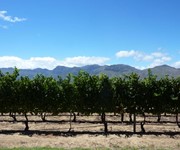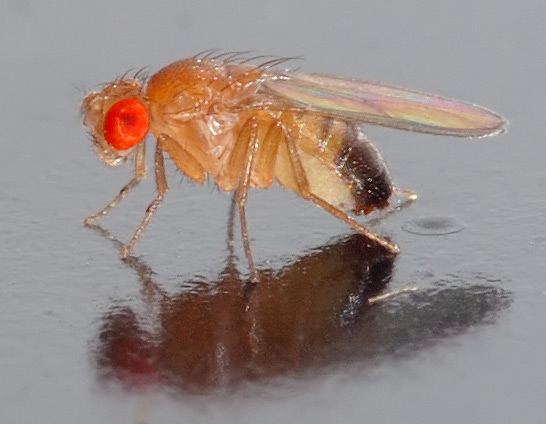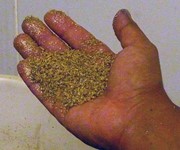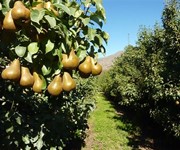loveFOOD visits South Africa Part 2

In the second part of an exclusive diary, Charlotte reports from the vineyards where her favourite wines are made, and confronts a swarm of unusual fruit flies.
Winning wines
 They say that potatoes picked from your own backyard are the best you’ll ever taste. I think the same applies to anything you eat or drink – as I mentioned in my first South African diary entry, the African Delight I picked at Babylonstoren farm was, although not yet ripe, the most delicious plum I’ve ever tasted. Unfortunately, no matter how short the supply chain is, a British supermarket plum will always taste inferior to one plucked from the mother tree over 6,000 miles away.
They say that potatoes picked from your own backyard are the best you’ll ever taste. I think the same applies to anything you eat or drink – as I mentioned in my first South African diary entry, the African Delight I picked at Babylonstoren farm was, although not yet ripe, the most delicious plum I’ve ever tasted. Unfortunately, no matter how short the supply chain is, a British supermarket plum will always taste inferior to one plucked from the mother tree over 6,000 miles away.
It’s just as noticeable with wine. South African whites are among my favourites (generally light, floral and refreshing), and my tour included visiting some of the vineyards which produce and bottle them. Franschhoek Valley is the country’s wine heartland, the mountainous slopes having been settled more than 300 years ago by the Huguenots, who brought with them their age-old French wine and food culture.
Dr Paul Cluver
 Retired brain surgeon Dr Paul Cluver is one of many wine entrepreneurs based in this area. The Cluver family have owned their 2,000+ hectare estate since 1896, farming grapes, apples and pears there. It’s also a UNESCO World Heritage site and, since the end of Apartheid in 1994, Paul has been on-hand to train those farm workers hoping to better themselves through programmes such as the Black Economic Empowerment (BEE) scheme (mentioned in my first diary entry).
Retired brain surgeon Dr Paul Cluver is one of many wine entrepreneurs based in this area. The Cluver family have owned their 2,000+ hectare estate since 1896, farming grapes, apples and pears there. It’s also a UNESCO World Heritage site and, since the end of Apartheid in 1994, Paul has been on-hand to train those farm workers hoping to better themselves through programmes such as the Black Economic Empowerment (BEE) scheme (mentioned in my first diary entry).
Indeed, Paul was the initiator of, and now mentor to, Thandi Wines (pictured here), a company established in 1999 as South Africa’s first agricultural BEE scheme. It’s owned by 250 farm worker families, who hold 55% of the shares. Thandi is the biggest black-owned exporting wine company in South Africa, and in 2003 became the first wine brand in the world to receive Fairtrade accreditation. It’s an example which other BEE farms are trying to follow, but not nearly enough of them are achieving similar successes.
That Gewürztraminer
 We had lunch on the Cluver estate (sitting outside on a sun-soaked lawn) and tried a couple of his wines. The Gewürztraminer was dangerously drinkable, with heady aromas of rose petals, lychee and cucumber, and a crystal clear finish. It was the perfect warm-weather wine, and went wonderfully with my vegetarian curry. It also added a certain something to see, in the near-distance, farm workers harvesting bunches of the same grape. They’ll be pressed, juiced, settled, fermented and bottled on-site over the coming months.
We had lunch on the Cluver estate (sitting outside on a sun-soaked lawn) and tried a couple of his wines. The Gewürztraminer was dangerously drinkable, with heady aromas of rose petals, lychee and cucumber, and a crystal clear finish. It was the perfect warm-weather wine, and went wonderfully with my vegetarian curry. It also added a certain something to see, in the near-distance, farm workers harvesting bunches of the same grape. They’ll be pressed, juiced, settled, fermented and bottled on-site over the coming months.
Luckily, you can find Cluver wines in the UK, too – just look in your local M&S, or head to WineTrust100, an online wine merchant site set up by my fellow South African traveller John Valentine. John was so taken with the Gewürztraminer that he decided, then and there, to list the bottle on WineTrust100; it will be available to buy in a couple of weeks’ time.
The pest problem
 But, alas, this trip isn’t just about drinking wine in the sunshine. We spent a good few hours at a fruit fly farm in Stellenbosch, which is testing an ‘environmentally friendly’ method of reducing the country’s fruit fly population. South Africa is host to the Mediterranean fruit fly and the Natal fruit fly (both are international quarantine pests), the females of which attack ripening fruit in order to lay their eggs. Just one lady fruit fly can infest more than 300 commercial hosts, and can produce approximately 400+ eggs in her lifetime. It’s estimated that crop losses and control costs as a result of fruit flies in the Western Cape alone amount to more than 20 million Rand per year (over £1,000,000). This is a huge blow, considering how important South Africa’s export deciduous fruit industry is to the country’s economy.
But, alas, this trip isn’t just about drinking wine in the sunshine. We spent a good few hours at a fruit fly farm in Stellenbosch, which is testing an ‘environmentally friendly’ method of reducing the country’s fruit fly population. South Africa is host to the Mediterranean fruit fly and the Natal fruit fly (both are international quarantine pests), the females of which attack ripening fruit in order to lay their eggs. Just one lady fruit fly can infest more than 300 commercial hosts, and can produce approximately 400+ eggs in her lifetime. It’s estimated that crop losses and control costs as a result of fruit flies in the Western Cape alone amount to more than 20 million Rand per year (over £1,000,000). This is a huge blow, considering how important South Africa’s export deciduous fruit industry is to the country’s economy.
Sterile solution
 Instead of blasting crops with insecticides (which could kill welcome insects such as bees and butterflies), FruitFly Africa practices Integrated Pest Management (IPM). Part of that involves identifying fruit fly ‘hot spots’ across South Africa, and then releasing sterile male fruit flies into these areas. It’s called the Sterile Insect Technique (SIT). In essence, it works by breeding fruit flies in a contained laboratory, destroying the female flies at egg stage by heating them to a high temperature (the male flies, who aren’t sensitive to heat, survive), and then sterilising the remaining male fruit flies by shooting gamma rays at them. Here's a photo of the flies above in their delightful maggot stage.
Instead of blasting crops with insecticides (which could kill welcome insects such as bees and butterflies), FruitFly Africa practices Integrated Pest Management (IPM). Part of that involves identifying fruit fly ‘hot spots’ across South Africa, and then releasing sterile male fruit flies into these areas. It’s called the Sterile Insect Technique (SIT). In essence, it works by breeding fruit flies in a contained laboratory, destroying the female flies at egg stage by heating them to a high temperature (the male flies, who aren’t sensitive to heat, survive), and then sterilising the remaining male fruit flies by shooting gamma rays at them. Here's a photo of the flies above in their delightful maggot stage.
Fifteen million sterile male fruit flies are released into South Africa every week, all of which will (hopefully) go on to mate with wild female fruit flies, whose eggs then obviously fail to hatch. It’s like birth control for insects. And because fruit flies are not indigenous to South Africa, Nando Baard from FruitFly Africa told us that reducing their numbers “will not affect the food chain – no-one will miss them!” You can read more about the SIT technique here.
Beautiful country, beautiful fruit
 The rest of our week was spent visiting fruit farms and vineyards, following the journey of a South African plum from plant to punnet, tasting new varieties of stone fruit and top fruit at the SAPO Trust laboratory (keep an eye out for the deliciously sweet ‘Carmen’ pear, which might be released to the UK market later this year), and eating/drinking our way through as much local produce as possible.
The rest of our week was spent visiting fruit farms and vineyards, following the journey of a South African plum from plant to punnet, tasting new varieties of stone fruit and top fruit at the SAPO Trust laboratory (keep an eye out for the deliciously sweet ‘Carmen’ pear, which might be released to the UK market later this year), and eating/drinking our way through as much local produce as possible.
South Africa is a stunning country, decorated throughout with mountainous backdrops, scenic coastal stretches, breathtaking sunsets, and beautiful wildlife. We saw baboons, pelicans, seals, sea lions and what looked suspiciously like a shark, all from the comfort of a minibus or boat.
 But in stark contrast to its beauty, post-Apartheid South Africa is still overwhelmed with problems. It’s impossible to overlook the abject poverty crippling the nation, and the marked lack of government funds and assistance going into services and infrastructure such as healthcare, childcare, and building projects within the townships. I’m not sure where the solution lies, and nor did most of the South Africans we asked. But deliberately buying South African fruit and wine, helping the industry recover from the offset of Apartheid boycotts, is a very simple way to help. And, as this trip affirmed, South Africa does produce, in my opinion at least, the best plums and white wines in the world.
But in stark contrast to its beauty, post-Apartheid South Africa is still overwhelmed with problems. It’s impossible to overlook the abject poverty crippling the nation, and the marked lack of government funds and assistance going into services and infrastructure such as healthcare, childcare, and building projects within the townships. I’m not sure where the solution lies, and nor did most of the South Africans we asked. But deliberately buying South African fruit and wine, helping the industry recover from the offset of Apartheid boycotts, is a very simple way to help. And, as this trip affirmed, South Africa does produce, in my opinion at least, the best plums and white wines in the world.
Photos taken by Charlotte Morgan during the trip, other than the fruit fly image (courtesy of Aka).
You might also like
loveFOOD visits South Africa Part 1
South African chef Reuben Riffel's recipes
Comments
Be the first to comment
Do you want to comment on this article? You need to be signed in for this feature